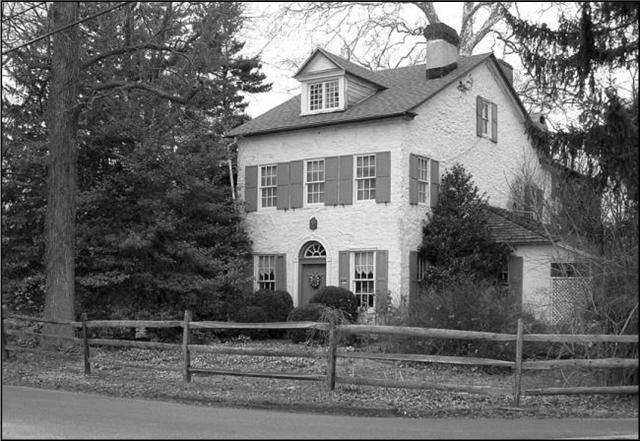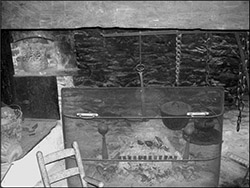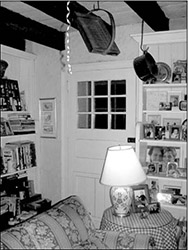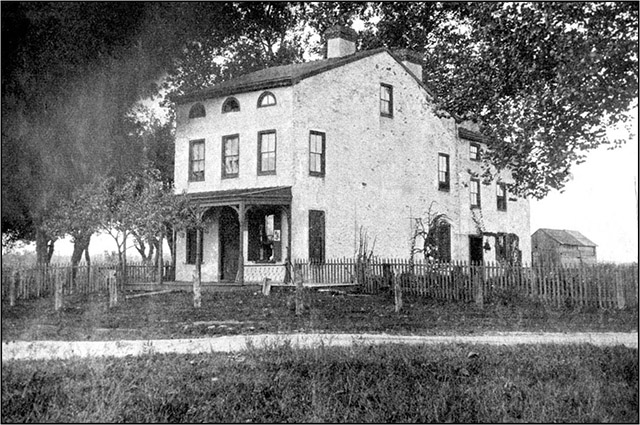|
Home : Quarterly Archives : Volume 43 |
|||
Tredyffrin Easttown Historical Society |
|||
|
Source: Fall 2006 Volume 43 Number 4, Pages 107–111 The Blue Ball Inn of Tredyffrin Township
Editor's note — Caroline won the Gold Award, the top prize, in the first
annual Mildred Kirkner Memorial Essay Contest sponsored by the Tredyffrin Easttown
Historical Society for juniors and seniors at Conestoga High School. She wrote
her essay in the spring of 2006 when she was a junior and was awarded the prize
of $250 in the fall of 2006. I probably pass by the Blue Ball Inn at least a dozen times a week. It's not that I don't notice it standing majestically on the corner of Russell and Old Lancaster Roads. It is a well-kept federal style home that is beautifully decorated in winter with fruit embellished wreaths on the doors and pine swags lit by glowing white candles in the windows. In the spring yellow daffodils dot the landscape, in the summer giant trees give the home well-deserved shade, and in the fall that same beautiful foliage highlights the property with reds and golds. However, the quick bend in the road only gives you a momentary glimpse of a home that has so much more to tell. The Blue Ball Inn was one of the first public houses in the country and is one of the last remaining inns left on the Conestoga trail. “The Ball,” as it is sometimes referred, was witness to the transformation of a group of desolate pioneering townships into a lively, progressive area for commerce and trade. It is a part of history that has endured three centuries filled with social, technological, industrial and economic change. The Blue Ball Inn has adapted and its history plays an integral role in the change and development of southeastern Pennsylvania.
Blue Ball Inn at the corner of Russell and Old Lancaster Roads. Today the historic Blue Ball Inn is the residence of Ron and Carol Kehler. Upon visiting them I discovered that they bought the inn in 1980 and have lived there and proudly maintained its integrity ever since. They are warm and welcoming, delivering the history of the old inn with such pleasure. I entered the home through the kitchen, which apparently is not the original kitchen, where Prissy Robinson would have been found stirring her lamb stew. Journeying through the living room, it was explained to me that this was the tavern section of the inn with its two large fireplaces and wide Pennsylvania Long Leaf Pine floors, a tree that is now extinct. One could almost hear the clanging of mugs as men with hearty laughs gathered after their long day's journey from Philadelphia. We stepped down to their family room, the original kitchen in the home with a gigantic walk-in fireplace and two outside entries facing each other. Mr. Kehler explained that the two doors were necessary for the horses to pull in large logs through the first door, drop it, roll it into the fireplace, and the horse would exit through the adjacent door. Adorning the ceiling is the original ladder that would pull down for overnight guests to climb to their bunk, four or five to a bed, or to curl up on the floor. We sat and conversed for more than an hour and I learned more from them than any Chester County history book I could find in the library.
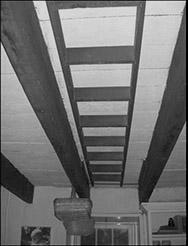
There was an aura to this house and my senses told me that Prissy Robinson, the notorious proprietress of the Blue Ball Inn was listening too! To discover the importance of the Blue Ball Inn it is important to realize these early times. Prior to the formation of Tredyffrin Township, the area was home to the friendly and hospitable Lenni Lenape Indians, who lived in villages as farmers and hunters. The presence of the Lenape in this area diminished over time with the introduction of the Welsh settlers, however, many of the trails they established became the pathways for the new pioneers. Tredyffrin Township had its beginning in 1682, when a group of Welsh Quakers went to William Penn and purchased 40,000 acres of land in southeastern Pennsylvania for ten cents an acre. This land grant provided for the Welsh religious freedom and rich, fertile soil for farming. It was named Tredyffrin because “tre” meant town and “dryffrin” meant a cultivated valley. These first settlers farmed the productive valleys of Chester County. They grew corn, barley, oats, rye and wheat and soon were in need of mills. Before long, Thomas Jarman constructed the first of many mills, the Great Valley Mill, in 1710. As more settlers arrived there was also the spiritual and social need for a meetinghouse. Many churches sprung up in the early 1700s, such as the Great Valley Presbyterian Church in 1710, and the Valley Friends Meeting House in 1714. As this tract of land developed the settlers began to travel. Conestoga (1682), Old Gulph (1690), and Swedesford (1713) Roads were the oldest byways in the area, cleared as former trails by the Lenape. As the township grew, so did the city of Philadelphia. This growth required food and livestock and so the farmers to the west supplied the markets of the city. Growing numbers ventured to Philadelphia, sometimes nearly sixty miles, to sell produce, grains and livestock and returned with material goods and/or the money from their sales. Travel was long and difficult along these primitive roads, and the need for public houses arose. Public houses, such as the Blue Ball Inn, allowed travelers, drovers and peddlers to stop for the night and get some food and drink before carrying on. Conestoga Road became a very popular road for these inns and taverns. The first Blue Ball Inn was the second house built in the Daylesford area. It is still standing today on Glenn Avenue in Berwyn. The original name for the inn was the “Halfway House” because it was just about halfway between the Schuylkill and Brandywine Rivers, as well as between the two Churches of England, St. Peter's in the Great Valley, and St. David's in Devon. It was the oldest tavern in the county and the earliest owner noted was Robert Richardson, who was licensed for the Halfway House from 1735-1741. A charter by William Penn in 1681 made it necessary for taverns to have a license to serve alcohol. There were two types of licenses, one for all types of liquor and the other for beer and hard cider only. A sign was required outside the establishment that helped guests determine the type of clientele served inside. There were three different class structures of inns during these early years. A Stage Stand was a first class inn, usually named after a prominent person. A second-class inn would be called a Wagon Stand, an inn serving the middle class. Third, were the Drovers Stands, like The Ball, who served simple food, slept multiple persons to a room and had pens and barns to house animals. Besides serving the basic needs for overnight stays, the inns of the colonial times served as a hub for social gatherings and a source for information. There were no newspapers in the early years and news took long periods of time to spread, so these inns were a form of communication for many. In later years voting, mail collection, political meetings, military recruitment, public notices, appraising and auctions were held at the inns as well. During war times many generals and high-ranking military officials used these inns as their quarters. 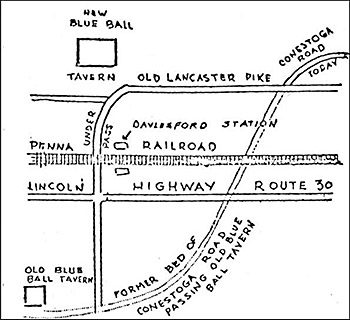
Map showing both Blue Ball Taverns. In 1741 the Halfway House changed hands and Thomas McKean, the uncle of Thomas McKean, signer of the Declaration of Independence, became the innkeeper. In 1757 the inn was renamed the Blue Ball Inn by the new owner, Thomas Wickinson. The name came from the blue ball attached to the hitching post which would be raised and lowered to alert coaches if passengers needed to be picked up. It is said that The Ball was a popular place for the troops of General Forbes and General Stanix, who marched to Ohio during the French and Indian War. The Ball again changed hands in 1760, when Bernhard Van Leer bought the 209-acre parcel. For the next twenty-five years Van Leer maintained ownership, but had tenant innkeepers, who ran the inn for him. The Blue Ball Inn was well known because it was one of the busiest places between Lancaster and Philadelphia. In 1786 Van Leer died and Mary and Moses Moore, the daughter and son-in-law of Van Leer, took over the inn and soon decided to build a new Blue Ball in 1796, which would be closer to the newly opened Lancaster Turnpike. In the early 1770s the State Assembly realized how bad the roads were, especially in the winter and early spring, when hundreds of wagons would get stuck, wheel-deep in the snow and mud. A bill was passed on April 9, 1792 to build the first toll road in America. It would extend from Philadelphia to Lancaster, and shares of stock were sold to investors to finance the project. John Loudon McAdam, a Scotsman, was hired as the designer, and so the material used, a solid stone base, was later named macadam. After the 62-mile turnpike was completed in 1794, at a cost of $465,000, money was collected from travelers at nine different tollgates. Rates varied from 1/8 of
This earliest known photograph of the second Blue Ball Inn was taken in 1895, almost 100 years after it was established in 1796. Photograph by Moses King. a dollar to 3/8 of a dollar, depending on the number of animals being herded, the number of wheels on a carriage, or the number of horses pulling. The toll road was an immediate financial success, which in turn meant a successful inn business. Philadelphia, with its new turnpike, became the largest commercial center on the Atlantic coast by the early 1800s. 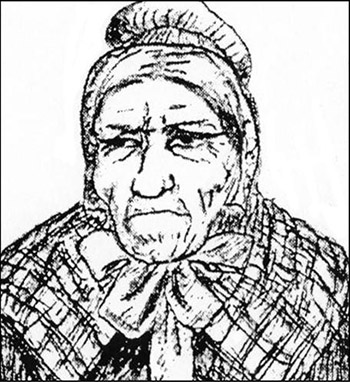
Above: Prissy Robinson. Artist unknown. 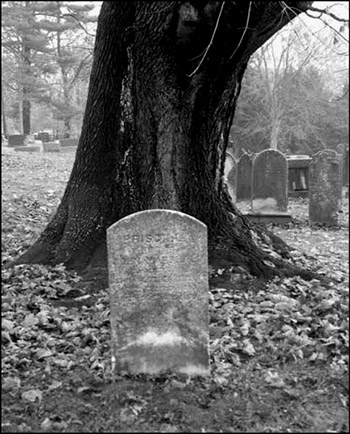
Priscilla Moore, otherwise known as “Prissy,” inherited the inn from her mother, Mary Moore, in the early 1800s. She served as innkeeper for more than 50 years at the Blue Ball, and is well remembered for her quick temper and her sharp tongue. Prissy was married to Edward Robison, John Cahill and John Fisher, all of whom mysteriously disappeared. A few travelers were also heard to have vanished during a nights stay at the Blue Ball. Needless to say, strange stories circulated about Prissy. Legend has it that guests would sometimes be awakened by muffled cries in the night and scraping noises, like that of a shovel on hard dirt, only to be served steaming black coffee and sugared doughnuts by Prissy in the morning. One wealthy woman was found hung at the inn and Prissy claimed it to be suicide. Prissy lived to be 100 years old and is buried in the old section of the cemetery at the Great Valley Presbyterian Church. Her tombstone simply reads:
Priscilla Robison Cahill The dark tales rumored about Prissy were never substantiated until many years later when six skeletons were found buried under the kitchen. It is alleged that Prissy, perhaps enticed by peddlers returning from Philadelphia with heavy pockets of money, killed her victims, buried them and hid their valuables somewhere in the house. The era of the inn was not to last. On June 21, 1831 the Legislature passed an act for the Philadelphia & Columbia Railroad to be built between the Schuylkill and Susquehanna. It opened in 1834 and the goods formerly transported by way of the turnpike were being taken by the faster, more efficient rail system. The toll road was eventually divided up, and sold for a mere $40,000, The railway spoiled much of the tavern business, and innkeepers like Prissy were hard pressed as they watched their trade slip away and their inns become unkempt. The story goes that Prissy, angry with the trains, would stand by the tracks, shake her fists, and scream obscenities at the trains as they passed. One day a passing train hit one of Prissy's calves and she demanded payment for her loss. Prissy went ignored until she began to grease the tracks, so that on the ascent to Paoli, the train would merely spin its wheels. She received her payment soon after. In 1894, the Blue Ball Inn was sold as a residence, and remains one today. Many believe that Prissy Robison, roused from the dead, haunts the Blue Ball today. In Prissy's former bedroom, drawers have been seen opening and closing. It has been suggested the Prissy may be looking for clean clothing to replace her bloodstained ones. One former owner said she saw a vision of an old, wrinkly woman, with a white bonnet, that disappeared when she spoke to her. Another owner described the presence of a hand resting on his shoulder, and turned around and found no one there. In 1980, right before the Kehler family moved in, they decided to find Prissy's grave. Carol Kehler described being drawn up the hill right away to one particular stone, amongst the hundreds, only to find that it was Prissy's. Soon after moving in, Carol remembered being paid a visit by a man who said his mother was a friend of Prissy. She let him in and he seemed to wander knowingly around the house. He finally asked if they ever found the money Prissy had hidden. Responding “no,” the old man suggested that it might be behind a hollow stair that he showed her. It was not. The man left and the Kehlers never saw him again. Mr. Kehler described a series of three knocks often heard on the doors, and opening it to find the doorway always empty. I inquired about the Underground Railroad. Apparently the house is said to have underground tunnels linking it to other houses in the area, but the Kehlers never found evidence, nor could I find any material to substantiate the claim. Doors that open and close on their own, dogs growling at nothing, and books frequently falling off shelves are common occurrences at the Blue Ball. Maybe Prissy does haunt this old inn. As I wrapped up the remainder of my visit at the Blue Ball Inn, I decided to take some pictures. I took pictures of the old ladder, some doors, and as I went to shoot the fireplace in the former kitchen, my camera sparked a funny light and I could not push the button to take the picture. The Kehlers suggested that I take some in the tavern room and then go back. My camera worked everywhere else, so I returned to take the kitchen fireplace again. Again the camera sparked and would not engage. Carol Kehler smiled and remarked, “Well, so that is where old Prissy hid her money.” Could Prissy be preventing me from taking a picture? And so ended my visit to the Blue Ball Tavern. The call gave me a chance to visualize history. The late 1700s and early 1800s was a time of great growth and prosperity for southeastern Pennsylvania. The Philadelphia-Lancaster Turnpike allowed not only commerce to flourish, but also the tavern business. Some thirty years later another mode of transportation, the railroad, virtually wiped out these same inns. The Blue Ball Inn stands today, as a remembrance of a time gone by, but the ghost of Prissy Robison does not let us forget. Bibliography Mr. John and Mrs. Carol Kehler interviewed 4 April 2006. “Mary Van Leer-Generation 8.8 - Eighth child of Berhardhus Van Leer,” 1 April 2006. http://www.vanleerplus.org/8mary.htm
McIndoe, Mary. Inns and Taverns of the Area. 1 April 2006. Tredyffrin Easttown Historical Society Quarterlies. 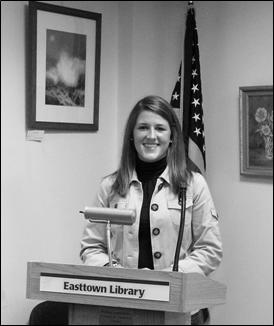
Caroline Hager presented her winning Mildred Kirkner Memorial Contest Essay at the November 19, 2006 meeting of the Tredyffrin Easttown Historical Society. She is an honors senior at Conestoga High School and plans to attend Loyola College in Baltimore next fall, playing lacrosse and pursuing a degree in speech pathology. |
|||
